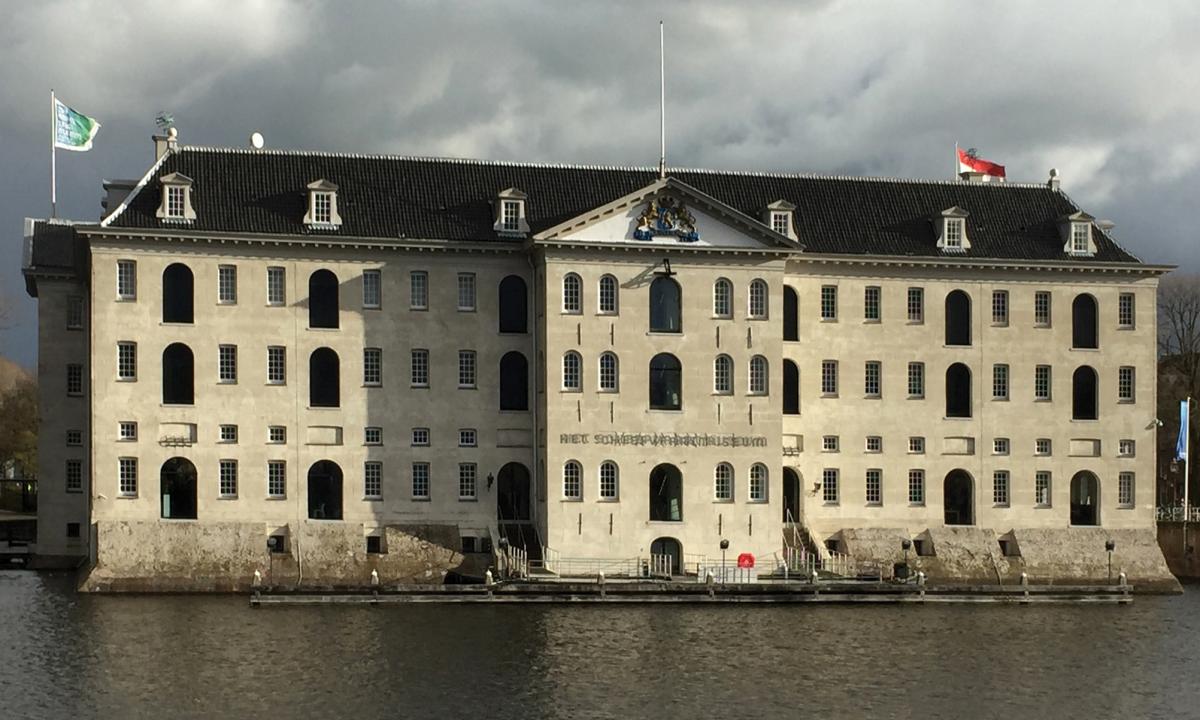The small kingdom of the Netherlands played an outsized role in international commerce, exploration, and warfare in the 16th through 18th centuries. The Scheepvaartmuseum, its national maritime museum, expertly interprets the history of this sturdy, sea-going nation.
Het Scheepvaartmuseum ranks as one of the most comprehensive and best-designed museums of the sea in Europe. Located on Amsterdam’s busy port complex, it occupies the Dutch Navy’s former headquarters and storehouse. The galleries in the multistory stone building take visitors through five centuries of Dutch maritime history, with an emphasis on the 17th century, the “Golden Age” of Dutch seafaring.
The Golden Age Gallery, located in the Westen (West) Wing is a family-friendly exhibit filled with well-presented artifacts, paintings, ship models, and more. The Dutch were ambitious and aggressive traders. To protect their trade, they often fought with other European nations, especially England. Michiel de Ruyter (1607–76) defeated the British in numerous battles, becoming Holland’s most famous and beloved admiral. The gallery holds his 1667 portrait and sword.
The Golden Age was tumultuous, a time of transition and disruption, wealth for some and poverty for others. At the entrance to this gallery, projected onto scrims, are five life-size characters from different social strata who talk about their lives and hopes for the future. They reappear to explain how and why their lives have changed. This one-on-one presentation gives personal and effective insights into this important era of Dutch history.
Returning to Dutch trade, the massive Port of Amsterdam exhibit uses an extensive collection of current raw materials, ship models, photos, and even two magnificent stained-glass panels from the Vinke Shipping Company to document the city’s place as Europe’s fourth-busiest port. A video screen 15 feet high and 65 feet long provides an aerial view of today’s active port. One floor above, in the Noord (North) Wing, the Maritime Gamechangers exhibit displays the only full-size replica, although conjectural, of Cornelis Drebbel’s wooden submarine of 1620.
The Oost (East) Wing could be a complete museum in itself with its splendid collections of maritime paintings, ship decorations, atlases, and navigational instruments. In the Painting Gallery, dozens of pictures large and small depict Dutch commerce and naval might. A 1675 work by Willem van de Velde the Younger celebrates the burning of England’s Royal James by a Dutch fireship at the Battle of Solebay in 1672.
The sounds of the rolling surf immerse you in the Ship Decorations Gallery. Figureheads ranging from Greek warriors to a buxom lady in a top hat jostle in large display cases. Finely worked catheads, mast-tip decorations, mast shields, and coats of arms demonstrate the skills of Dutch carvers.
The Navigational Instruments Gallery with its atmospheric lighting and fields of stars is an informative journey through the history of sailors’ efforts to determine their position and avoid shipwreck. Using navigational equipment ranging from cross-staffs to chronometers, the exhibit introduces visitors to the complexity of knowing where your ship is and where danger awaits.
The adjacent Chart & Atlas Room offers one of the most impressive collection of globes, atlases, and charts to be found on display anywhere. These include an edition of Ptolemy’s world map of 1482, a 1515 parchment portolan, and Joan Blaeu’s massive 17th-century atlases.
Some 75 ship models—ranging from a 17th-century workhorse boyer with its large midships steering boards to a 2010 racing yacht—fill the Model Gallery. Foot-weary visitors will find the Album Room a comfortable resting place where they can nestle in upholstered wingback chairs and browse albums of historic photos, as hidden speakers in the chair narrate the pages.Het Scheepvaartmuseum makes it easy to enjoy a half-day visit. Easily accessible from the central courtyard are ticket sales, a shop, and a restaurant. Elevators make all floors accessible. Complementary multilanguage audio guides provide excellent explanations of the exhibits. English speakers will appreciate that the exhibit text also is offered in English.






